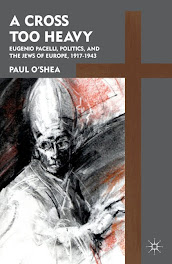ADSS 8.141: Gabriel Apor, Hungarian Ambassador to the Holy See to Cardinal Maglione
Reference: No number; AES 7410/41
Location and
date: Rome 06.09.1941
Summary
statement: Justification for the Antisemitic laws in Hungary
Language: French
Text:
In reference to
the letter of 13.08.1941 (1), I have the honour to communicate to Your Eminence
the following:
The Hungarian
Government has read, with sincere regret, the concerns Your Eminence expressed
related to the introduced reforms to Hungarian marriage legislation.
The population
of Hungary is – as is commonly known – is composed of different religions. Therefore there has been a need for
forty-seven years for the Hungarian State to regulate the institution of
marriage by law and introduce legislation for obligatory civil marriage.
Since 1894 (2),
the Hungarian Government has thus, invariably, taken the point of view that the
regulations of the institution of marriage is a task that falls to the State,
and therefore the Hungarian Government has never – since then – amended its
point of view on this principle.
Political
interests vital to the country require the Hungarian Government to introduce
new prohibitive measures to matrimonial legislation. These important interests have emerged from
consequences, in part, from the general European situation, and in part, from
special social conditions in Hungary, which have been exposed repeatedly by
qualified representatives of the government to Parliament and have been
expressed by the Prime Minister (3) to His Excellency the Apostolic Nuncio. (4)
During the
discussions of the proposed law in question, the Hungarian Government
endeavoured to take into account the points of view expressed by His Excellency
the Apostolic Nuncio and His Eminence the Cardinal Prince-Primate (5) insofar
as the political circumstances that made the reforms inevitable, allowed it.
The Hungarian
government, for its part, ensures the Holy See, that within the framework of
the law, has not lost sight of the considerations the Church attaches – on its
part, a very high importance – when it comes to the execution and practice of
the law.
The Hungarian
Government sincerely regrets if these concessions have not entirely satisfied
the Holy See, but expresses the hope that this matter will not affect the
traditional friendly relations that have existed with Hungary since the time of
our first king, St Stephen. (6)
References:
(1) ADSS 8.128
(2) “In
1894-1995, a severe domestic conflict erupted in Hungary. The Liberal
government then in power introduced legislation aimed at separating church and
state. The reforms with regard to the
tole of the Catholic Church made civil marriage and birth registry obligatory,
legalised divorce, granted Judaism equality with other faiths, and left it to
parents in an interfaith marriage to decide what religious their children
should follow. These secularisation laws
were strongly opposed by the Catholic clergy and conservative magnates in the
upper house of the Hungarian parliament.
The laws finally were passed when Emperor Francis Joseph, who had
disliked the secularisation laws and procrastinated in his support of the
Hungarian government, finally put pressure on the magnates to vote for the
bills in order to avoid a prolonged crisis”. Solomon Wank (2009), In the Twilight of Empire: count Alois Lexa
von Aehrehthal (1854-1912) Imperial Hapsburg Patriot and Statesman, Volume
1, p 146. See too Paul Hanebrink (2006),
In Defense of Christian Hungary:religion,
Nationalism and Antisemitism 1890-1944,
pp 23-28. Many of Hungary’s senior clergy had been young priests during
the bitter clash over the introduction of civil marriage in 1894 and most saw
it as a major loss for the rights of the Church.
(3) Laszlo von
Bardossy (1890-1945), Prime Minister 1941-1942
(4) Angelo Rotta
(1872-1965), Nuncio 1930-1945
(5) Justinian
Seredi (1884-1945), Cardinal Primate 1927-1945
(6) St Stephen I, Duke (997-1000) and first King of Hungary (1000-1038).
Arms of the Regency of Hungary





No comments:
Post a Comment
You are welcome to post a comment. Please be respectful and address the issues, not the person. Comments are subject to moderation.